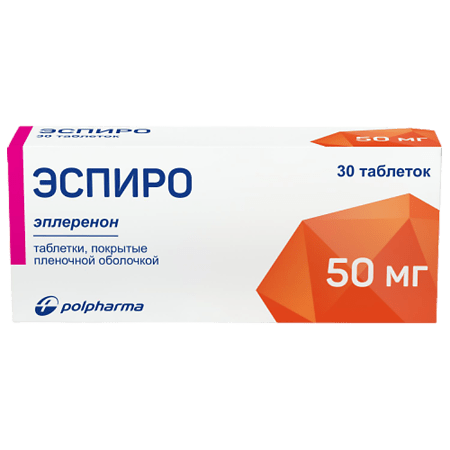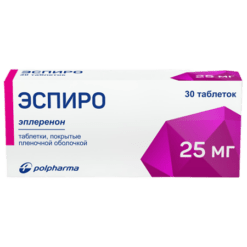No products in the cart.
Espiro, 50 mg 30 pcs.
€37.55 €31.29
Description
A potassium-saving diuretic.
Eplerenone is highly selective for mineralocorticoid receptors in humans in contrast to glucocorticoid, progesterone and androgen receptors and prevents binding of mineralocorticoid receptors to aldosterone, a key PAAC hormone that is involved in BP regulation and pathogenesis of cardiovascular disease.
Eplerenone causes a persistent increase in plasma renin and serum aldosterone activity. Subsequently, renin secretion is inhibited by aldosterone through a feedback mechanism. At the same time, an increase in renin activity or circulating aldosterone concentration does not affect the effects of eplerenone. No significant effect of eplerenone on HR, duration of QRS, PR or QT intervals was found in healthy volunteers.
Indications
Indications
– myocardial infarction: in addition to standard therapy to reduce the risk of cardiovascular mortality and morbidity in patients with stable left ventricular dysfunction (ejection fraction less than 40%) and clinical signs of heart failure after myocardial infarction;
– chronic heart failure: in addition to standard therapy to reduce cardiovascular mortality and morbidity in patients with chronic heart failure functional class II according to the NYHA classification with reduced left ventricular ejection fraction.
Pharmacological effect
Pharmacological effect
Potassium-sparing diuretic.
Eplerenone has high selectivity for mineralocorticoid receptors in humans, in contrast to glucocorticoid, progesterone and androgen receptors, and prevents the binding of mineralocorticoid receptors to aldosterone, a key PAAC hormone that is involved in the regulation of blood pressure and the pathogenesis of cardiovascular diseases.
Eplerenone causes a persistent increase in the activity of renin in the blood plasma and aldosterone in the serum. Subsequently, renin secretion is suppressed by aldosterone via a feedback mechanism. However, an increase in renin activity or circulating aldosterone concentration does not affect the effects of eplerenone. No significant effect of eplerenone on heart rate, QRS, PR or QT intervals was detected in healthy volunteers.
Special instructions
Special instructions
Hyperkalemia
When treated with Espiro, hyperkalemia may develop, which is due to its mechanism of action. At the beginning of treatment and when changing the dose of the drug in all patients, the concentration of potassium in the blood serum should be monitored. In the future, periodic monitoring of potassium levels is recommended in patients with an increased risk of developing hyperkalemia, for example, in elderly patients, patients with renal failure and diabetes mellitus. Given the increased risk of developing hyperkalemia, the administration of potassium supplements after initiation of treatment with Espiro is not recommended. Reducing the dose of Espiro leads to a decrease in the concentration of potassium in the blood serum. In one study, the addition of hydrochlorothiazide to eplerenone prevented the increase in serum potassium concentrations.
Renal dysfunction
In patients with impaired renal function, incl. diabetic microalbuminuria, it is recommended to regularly monitor the concentration of potassium in the blood serum. The risk of developing hyperkalemia increases with decreased renal function. Although the number of patients with type 2 diabetes mellitus and microalbuminuria in the studies was limited, an increase in the incidence of hyperkalemia was noted in this small sample. In this regard, treatment should be carried out with caution in such patients. Eplerenone is not removed by hemodialysis. The use of Espiro is contraindicated in severe renal failure.
Liver dysfunction
In patients with mild or moderate liver dysfunction (5-6 and 7-9 points on the Child-Pugh scale), an increase in serum potassium concentration of more than 5.5 mmol/l was not detected. In such patients, electrolyte levels should be monitored. Eplerenone has not been studied in patients with severe hepatic impairment and is therefore contraindicated.
CYP3A4 inducers
Concomitant use of Espiro with strong CYP3A4 inducers is not recommended.
Cyclosporine, tacrolimus, drugs containing lithium
During treatment with Espiro, these drugs should be avoided.
Lactose
The tablets contain lactose and should not be prescribed to patients with rare hereditary diseases such as lactose intolerance, lactase deficiency and glucose-galactose malabsorption syndrome.
Impact on the ability to drive vehicles and operate machinery
The effect of Espiro on the ability to drive vehicles or use complex equipment has not been studied. However, given the drug’s ability to cause dizziness and fainting, caution should be exercised when driving vehicles or using complex equipment while taking Espiro.
Active ingredient
Active ingredient
Eplerenone
Composition
Composition
1 tab.
eplerenone 50 mg.
Excipients: lactose monohydrate – 77.34 mg, microcrystalline cellulose – 30.76 mg, hypromellose 15cP – 2.5 mg, sodium lauryl sulfate – 1.7 mg, croscarmellose sodium – 6 mg, magnesium stearate – 1.7 mg.
Shell composition: opadry II 33G32578 (yellow) – 8 mg (hypromellose 6cP (E464) – 3.2 mg, titanium dioxide (E171) – 1.82 mg, lactose monohydrate – 1.68 mg, macrogol 3350 – 0.64 mg, triacetin – 0.48 mg, iron dye yellow oxide (E172) – 0.18 mg).
10 pcs. – blisters (3) – cardboard packs.
Contraindications
Contraindications
– clinically significant hyperkalemia;
— the concentration of potassium in the blood serum at the beginning of treatment is more than 5 mmol/l;
– moderate or severe renal failure;
– severe liver failure (more than 9 points on the Child-Pugh scale);
– concomitant use of potassium-sparing diuretics, potassium supplements or strong CYP3A4 inhibitors, for example, itraconazole, ketoconazole, ritonavir, nelfinavir, clarithromycin, telithromycin and nefazodone;
– plasma creatinine concentration >2 mg/dL (or >177 mmol/L) in men or >1.8 mg/dL (or >159 mmol/L) in women;
– lactase deficiency, lactose intolerance, glucose-galactose malabsorption syndrome;
– children and adolescents under 18 years of age (there is no experience in using the drug in patients in this age group);
– hypersensitivity to eplerenone or other components of the drug.
The drug should be prescribed with caution for type 2 diabetes mellitus and microalbuminuria; simultaneous use of eplerenone, ACE inhibitors or angiotensin II receptor antagonists, drugs containing lithium, cyclosporine or tacrolimus, digoxin and warfarin in doses close to the maximum therapeutic; in case of renal dysfunction (KK
Side Effects
Side Effects
The following undesirable effects are given in accordance with the following gradation of the frequency of their occurrence according to the classification of the World Health Organization: very often (≥10%); often (≥1%).
From the hematopoietic system: rarely – eosinophilia.
From the endocrine system: infrequently – hypothyroidism.
Metabolism and nutrition: often – hyperkalemia, hypercholesterolemia, hypertriglyceridemia, dehydration; infrequently – hyponatremia.
Mental disorders: infrequently – insomnia.
From the nervous system: often – dizziness, fainting; infrequently – headache, hypoesthesia.
From the cardiovascular system: frequent – marked decrease in blood pressure, myocardial infarction; uncommon – atrial fibrillation, left ventricular failure, tachycardia, orthostatic hypotension, thrombosis of the arteries of the lower extremities.
From the respiratory system: often – cough; infrequently – pharyngitis.
From the digestive system: often – diarrhea, nausea, constipation; infrequently – flatulence, vomiting, cholecystitis.
From the skin and subcutaneous tissues: often – itching; infrequently – increased sweating.
From the musculoskeletal system: often – cramps of the calf muscles, musculoskeletal pain; infrequently – back pain.
From the urinary system: often – impaired renal function; infrequently – pyelonephritis.
Allergic reactions: infrequently – skin rash; frequency unknown – angioedema.
Other: infrequently – asthenia, malaise, gynecomastia.
Laboratory indicators: infrequently – increased concentrations of residual urea nitrogen, creatinine, decreased expression of the epidermal growth factor receptor, increased concentrations of glucose in the blood serum.
Interaction
Interaction
Pharmacodynamic interaction
Potassium-sparing diuretics and potassium supplements: Given the increased risk of hyperkalemia, eplerenone should not be administered to patients receiving potassium-sparing diuretics and potassium supplements. Potassium-sparing diuretics may enhance the effects of antihypertensive drugs and other diuretics.
Preparations containing lithium: The interaction of eplerenone with lithium preparations has not been studied. However, in patients receiving lithium preparations in combination with diuretics and ACE inhibitors, cases of increased concentrations and lithium intoxication have been described. If such a combination is necessary, it is advisable to monitor the concentration of lithium in the blood plasma.
Cyclosporine, tacrolimus: Cyclosporine and tacrolimus may cause renal impairment and increase the risk of hyperkalemia. Concomitant use of eplerenone and cyclosporine or tacrolimus should be avoided. If cyclosporine or tacrolimus is required during treatment with eplerenone, regular monitoring of serum potassium concentrations and renal function is recommended.
NSAIDs: Treatment with NSAIDs may lead to acute renal failure due to direct inhibition of glomerular filtration, especially in at-risk patients (elderly patients and/or patients with dehydration). When using these drugs together, it is necessary to ensure adequate fluid intake and monitor renal function before and during treatment.
Trimethoprim: Concomitant use of trimethoprim with eplerenone increases the risk of hyperkalemia. It is recommended to monitor serum potassium concentrations and renal function, especially in patients with renal insufficiency and in elderly patients.
ACE inhibitors and angiotensin II receptor antagonists: When using eplerenone with ACE inhibitors or angiotensin II receptor antagonists, serum potassium concentrations should be regularly monitored. Such a combination may lead to an increased risk of developing hyperkalemia, especially in patients with impaired renal function, incl. in elderly patients. The triple combination of an ACE inhibitor and an ARA II with eplerenone should not be used.
Alpha1-blockers (prazosin, alfuzosin): with simultaneous use of alpha1-blockers with eplerenone, the antihypertensive effect may be enhanced and/or the risk of developing orthostatic hypotension may increase, and therefore it is recommended to monitor blood pressure when changing body position.
Tricyclic antidepressants, antipsychotics, amifostine, baclofen: when used simultaneously with eplerenone, the antihypertensive effect may be enhanced or the risk of orthostatic hypotension may increase.
Glucocorticoids, tetracosactide: Concomitant use of these drugs with eplerenone may result in sodium and fluid retention.
Pharmacokinetic interaction
In vitro studies indicate that eplerenone does not inhibit the isoenzymes CYP1A2, CYP2C19, CYP2C9, CYP2D6 and CYP3A4. Eplerenone is not a substrate or inhibitor of P-glycoprotein.
Digoxin: The AUC of digoxin when administered concomitantly with eplerenone increased by 16% (90% CI: 4-30%). Caution must be exercised if digoxin is used in doses close to the maximum therapeutic dose.
Warfarin: No clinically significant pharmacokinetic interaction with warfarin has been identified. Caution must be exercised if warfarin is used in doses close to the maximum therapeutic dose.
CYP3A4 substrates: In specific studies, there was no evidence of pharmacokinetic interaction between eplerenone and CYP3A4 substrates, such as midazolam and cisapride.
CYP3A4 inhibitors:
– potent inhibitors of CYP3A4: when using eplerenone with drugs that inhibit CYP3A4, significant pharmacokinetic interaction is possible. A potent inhibitor of CYP3A4 (ketoconazole 200 mg 2 times / day) caused an increase in eplerenone AUC by 441%. Concomitant use of eplerenone with strong CYP3A4 inhibitors such as ketoconazole, itraconazole, ritonavir, nelfinavir, clarithromycin, telithromycin and nefazadone is contraindicated;
– weak and moderate inhibitors of CYP3A4: simultaneous use with erythromycin, saquinavir, amiodarone, diltiazem, verapamil and fluconazole was accompanied by significant pharmacokinetic interactions (the degree of increase in AUC ranged from 98% to 187%). When using these drugs simultaneously with eplerenone, the dose of the latter should not exceed 25 mg.
CYP3A4 inducers: concomitant use of drugs containing St. John’s wort (a strong CYP3A4 inducer) with eplerenone caused a decrease in the AUC of the latter by 30%. When using more potent inducers of CYP3A4, such as rifampicin, a more pronounced decrease in the AUC of eplerenone is possible. Given the possible decrease in the effectiveness of eplerenone, the simultaneous use of strong CYP3A4 inducers (rifampicin, carbamazepine, phenytoin, phenobarbital, drugs containing St. John’s wort) is not recommended.
Antacids: Based on a pharmacokinetic clinical study, significant interactions between antacids and eplerenone when used concomitantly are not expected.
Overdose
Overdose
There are no cases of eplerenone overdose in humans. The most likely manifestations of an overdose may be an excessive decrease in blood pressure and hyperkalemia.
Treatment: if blood pressure decreases excessively, maintenance treatment should be prescribed. If hyperkalemia develops, standard therapy is indicated. Eplerenone is not removed by hemodialysis. It has been established that eplerenone actively binds to activated carbon.
Manufacturer
Manufacturer
Polpharma JSC, Poland
Additional information
| Manufacturer | Polpharma S.A., Poland |
|---|---|
| Medication form | pills |
| Brand | Polpharma S.A. |
Other forms…
Related products
Buy Espiro, 50 mg 30 pcs. with delivery to USA, UK, Europe and over 120 other countries.
















